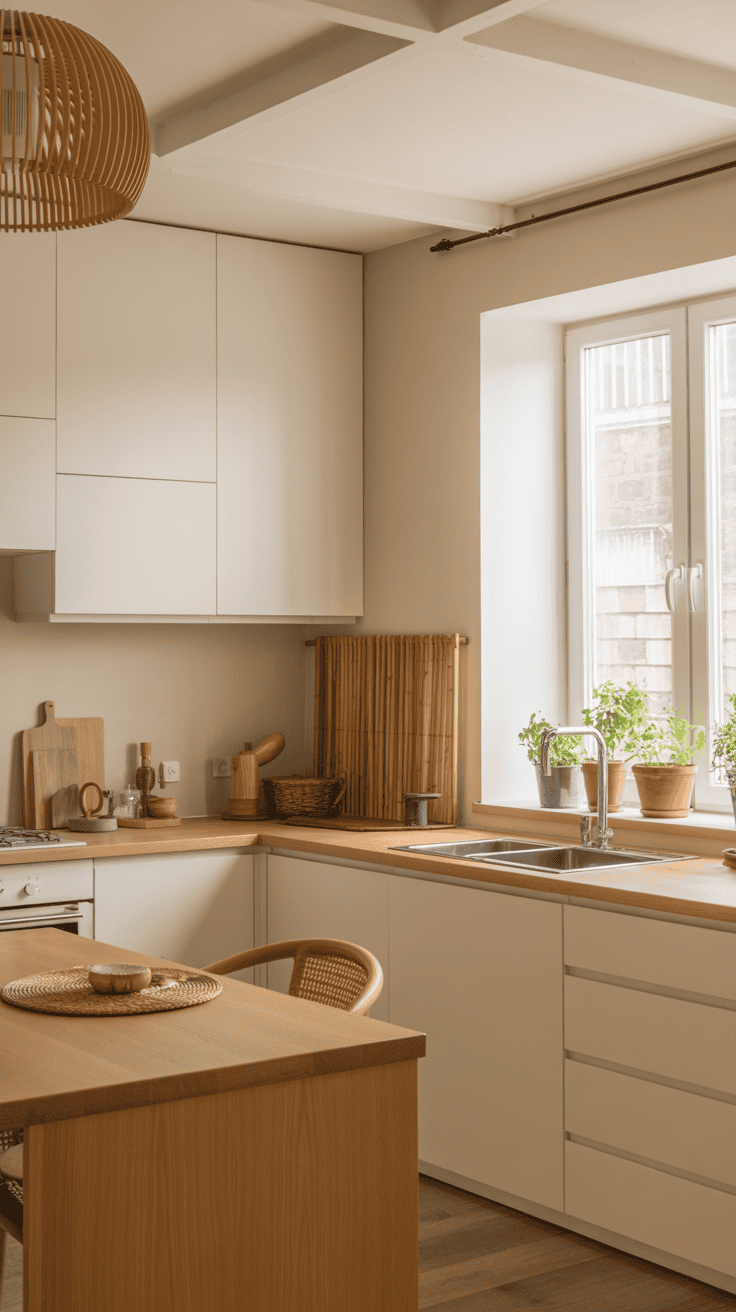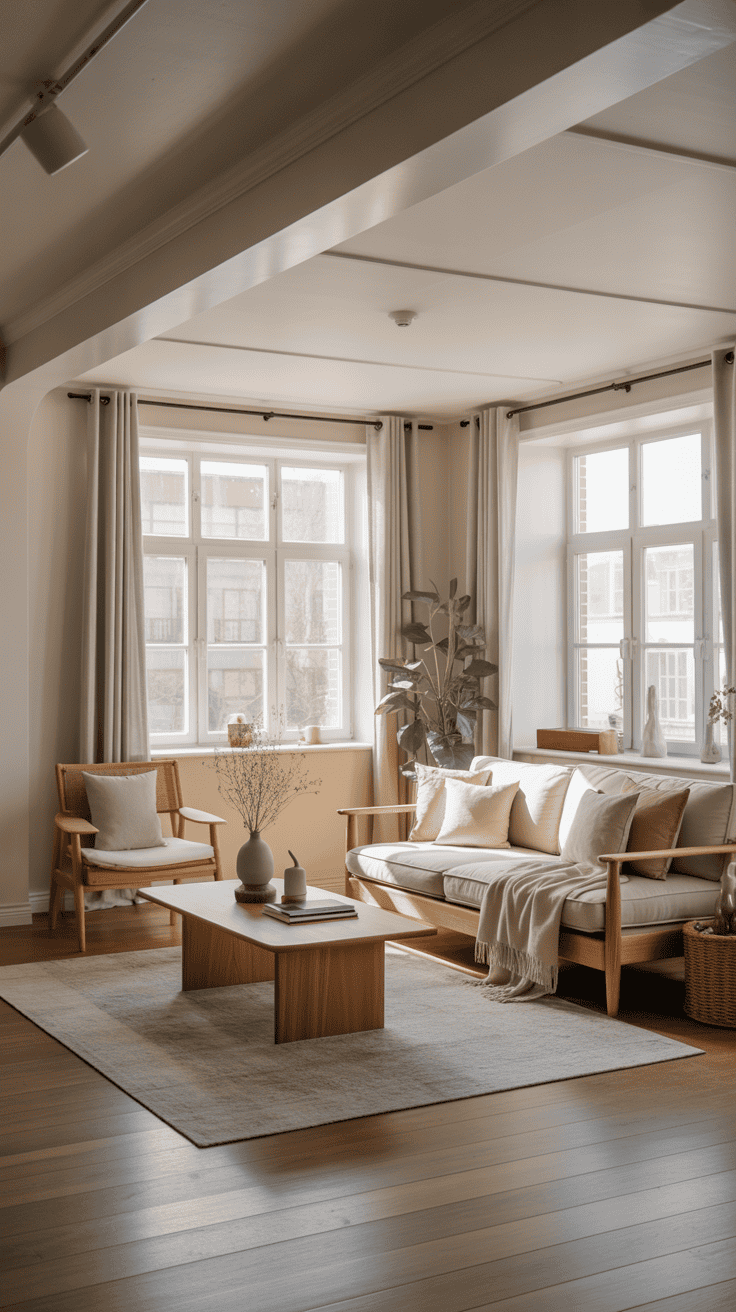This post shows 13 Minimalist Ideas Japandi Bedroom Interior Design!

Why Japandi Feels Like a Warm Hug (and Why Your Bedroom Needs It)
You know that feeling when you walk into a space and just exhale? That deep, calming breath like your stress just melted away? Yeah, that’s the Japandi vibe. If you’ve ever scrolled through Pinterest wondering how to make your bedroom feel peaceful, cozy, and uncluttered—without turning it into a sterile box—then this article’s for you.
Japandi bedroom interior design is where Japanese minimalism meets Scandinavian hygge. Think clean lines, cozy textures, and a sense of calm that hugs you the second you walk in. So, if your bedroom’s been feeling more “meh” than mindful, here are 13 Japandi design ideas that’ll wrap you in warm, minimalist bliss. And don’t worry—these aren’t just “for the aesthetic.” They’re practical, cozy, and (thankfully) renter-friendly too.
13 Minimalist Ideas Japandi Bedroom Interior Design!
1. Low-Profile Beds for Grounded Serenity
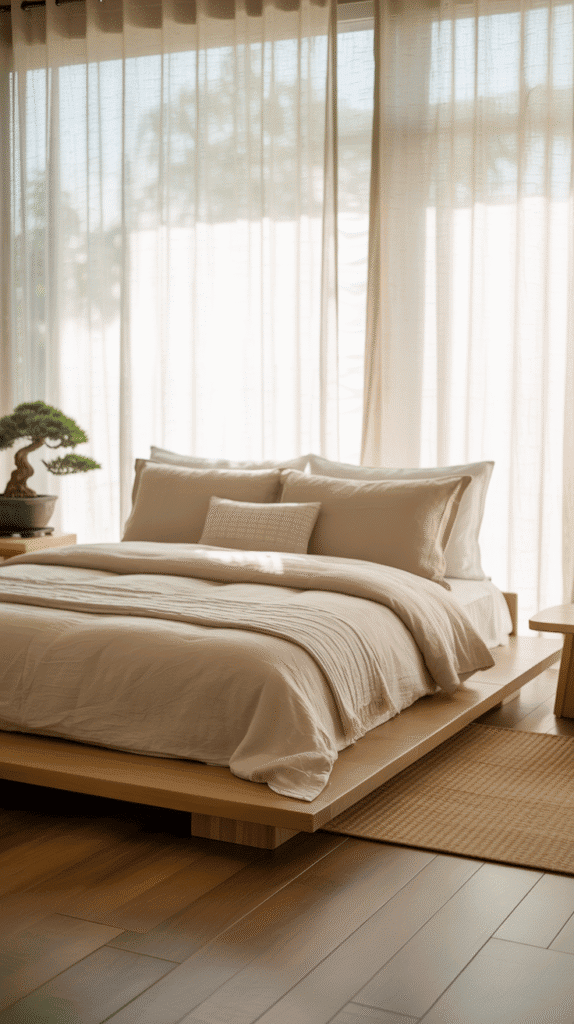
First up: the bed. In Japandi design, low-slung beds are kind of the main character. They’re not just trendy—they’re grounding. Literally.
Ever noticed how sleeping closer to the floor makes the room feel bigger? And cozier? It’s like camping, but make it chic. Choose beds with clean lines and simple wooden frames. No need for dramatic headboards or built-in tech. The minimalist vibe of a low bed helps your room feel calm and open—exactly what you want when you’re trying to unwind.
Pro tip: Go for frames in natural finishes like oak, ash, or walnut. Avoid glossy surfaces. The more natural it feels, the more “hug” energy it brings to your space. You can even ditch the bedframe altogether and place a quality mattress on a simple tatami-style mat. Yes, it’s a vibe.
Top it off with cozy textiles: a crinkled linen duvet, a cotton throw, maybe a bit of wool for texture. Add in some soft lighting and suddenly, your bed becomes less “functional sleeping station” and more “sanctuary of calm.” Who wouldn’t want that?
2. Neutral Earth-Toned Palette
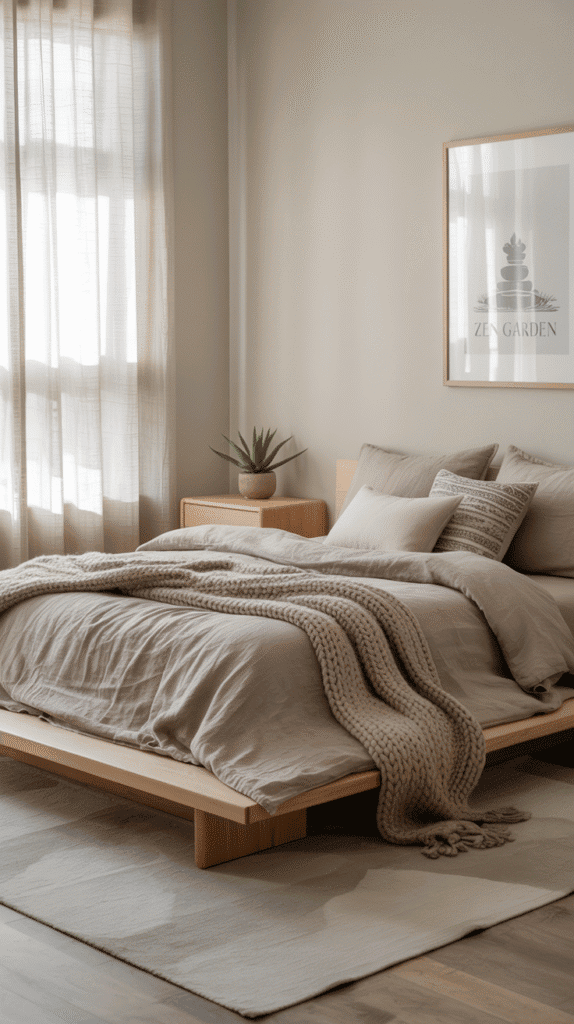
Raise your hand if you’re tired of gray everything. 🙋♀️ Japandi bedrooms love earthy, warm neutrals that make you feel like you’re wrapped in a fuzzy blanket of nature.
Think soft beiges, clay, taupe, oatmeal, and gentle greys. These tones are calming, timeless, and super easy on the eyes. They set the stage for relaxation, unlike colder tones that can make a room feel sterile.
Instead of bright white walls, try a soft warm white or a sandy beige. Paint isn’t your only tool here—textiles like linen curtains, throw pillows, or upholstered headboards in these shades can do wonders.
Want to play with color? Stick to nature-inspired hues like olive green, stone blue, or dusty rose. Just keep them muted. We’re not creating a rainbow—this is Japandi, not eclectic boho.
The goal is to create a balanced, breathable palette that doesn’t scream for attention. Every shade should whisper calm. Trust me, when everything matches your energy after a long day, you’ll thank yourself.
3. Tatami-Inspired Rugs
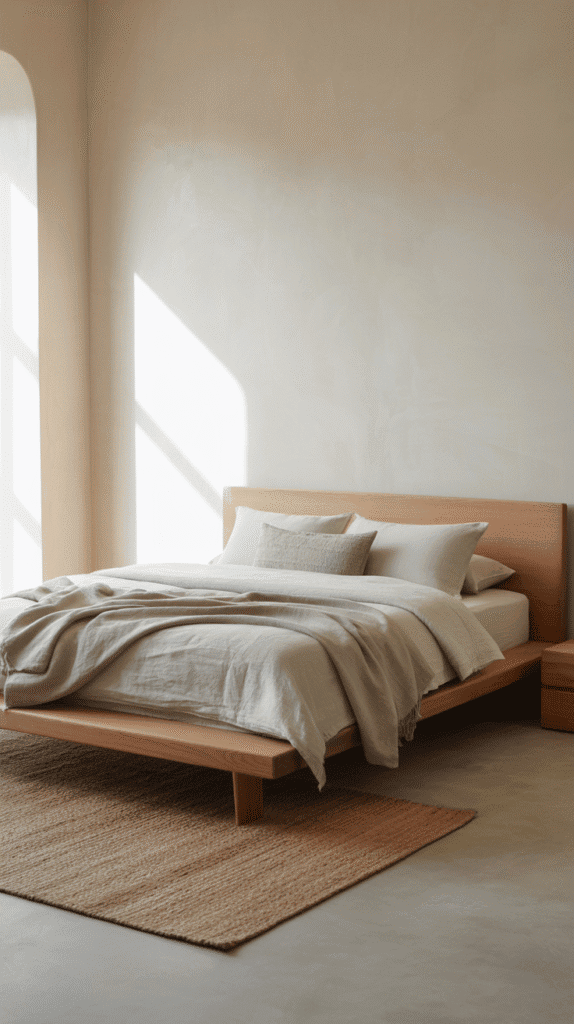
We’re not laying down real tatami mats here (unless you’re feeling super traditional), but you can absolutely nod to them with textured, natural rugs. They ground the room, both visually and literally, adding a cozy layer between your feet and the floor.
Look for materials like jute, sisal, or cotton. Flatweaves work best because they mimic the clean lines and simplicity of tatami. They also let your low-profile bed shine without looking bulky or out of place.
Want a bit of softness underfoot? Layer a small wool or faux-sheepskin rug at the bedside. It adds that Scandinavian “hygge” texture without interrupting the minimalism. It’s like wearing fuzzy socks over bare legs: weirdly perfect.
Stick to neutral colors or subtle patterns. Anything loud or high-contrast will break the calm vibe. Pro tip: use a natural rug as the base and add something softer on top where your feet land when you get out of bed. It’s those small details that make your space feel intentional.
4. Natural Wood Elements Everywhere
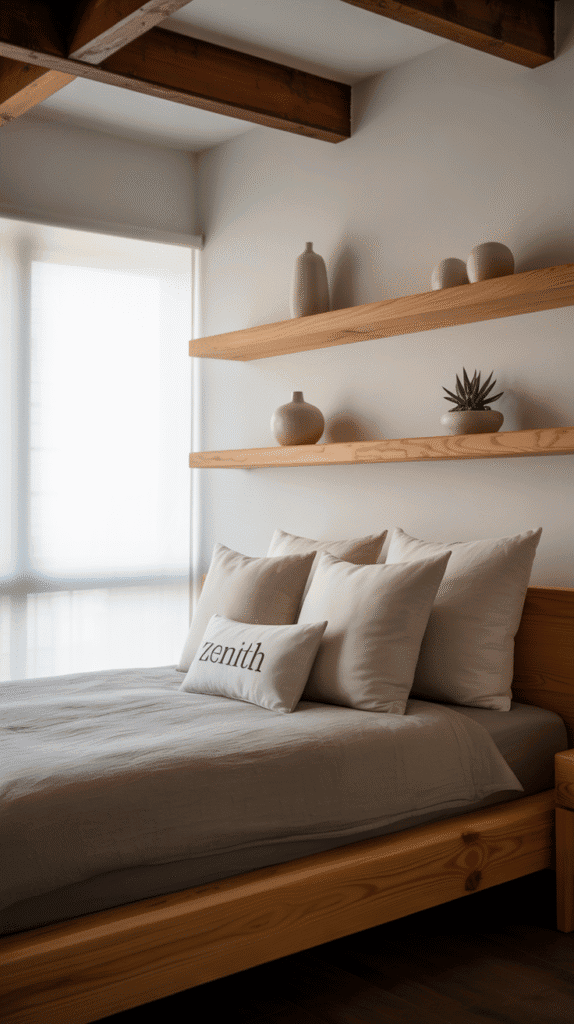
If Japandi had a love language, it would be natural wood. It’s calming, it’s warm, and it literally grows on trees. (See what I did there?)
In your bedroom, think beyond just the bedframe. Add wooden nightstands, a minimalist bench, floating shelves, or even a wood-slatted accent wall. These elements bring in warmth and visual interest without being fussy.
What makes Japandi wood pieces stand out is their simplicity and craft. You’re not looking for ornate carvings or super polished finishes. Instead, go for:
- Scandinavian light pine for that airy, fresh look
- Japanese walnut or cedar for deeper, richer tones
- Matte finishes to keep it grounded
Mixing tones can work as long as they don’t compete. Think soft harmony, not harsh contrast. Let the natural grain show and celebrate any little knots or imperfections. They add character.
Wood also pairs beautifully with stone, linen, and ceramic—so don’t be afraid to mix materials. That earthy combo is pure Japandi magic.
5. Paper Lantern or Pendant Lighting
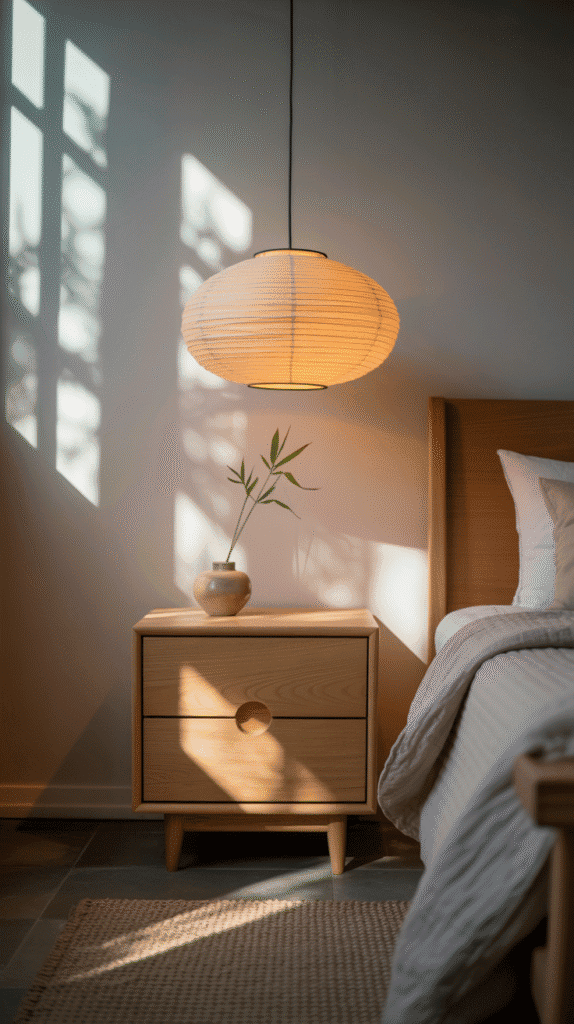
Mood lighting matters. You don’t want harsh LEDs buzzing above you. (I mean, who relaxes under a spotlight?) Japandi bedrooms thrive under soft, diffused light that makes everything feel a little more peaceful.
Paper lanterns or pendant lights made from rice paper, fabric, or natural fibers like rattan are your best bet. They spread light in a soft, warm way that instantly transforms the room’s mood.
The best part? They double as decor. A statement pendant above the bed or a pair of matching paper lanterns on either side can look stunning. It’s function and form. Win.
Bonus tip: Install dimmer switches. You’ll thank me when you’re winding down at night and don’t want to be blasted with overhead brightness.
And if you’re tight on space? Wall-mounted sconces with linen shades work beautifully too. Just keep everything soft, natural, and minimalist.
6. Streamlined Storage Solutions

Here’s the secret sauce: storage that disappears into the background. Japandi bedrooms avoid visual clutter at all costs, and that means hiding your mess in style.
Opt for furniture with clean lines and no visible handles. Think push-to-open drawers, wall-mounted shelves, or underbed bins. Everything should feel seamless.
Try these ideas:
- Underbed drawers: Great for off-season clothes or spare bedding.
- Wall shelves: Perfect for displaying 1–2 curated items. Not 20.
- Benches with hidden storage: Form meets function in the best way.
Stay away from open shelving unless you can keep it really minimal. One plant and a ceramic bowl? Yes. A dozen books, five candles, and tangled cords? No thanks.
IMO, the less your eyes have to “process,” the more relaxed your brain feels. It’s science. Probably.
7. A Statement Linen Duvet

Let’s talk bedding. If you want your Japandi bedroom to truly feel like a hug, then a linen duvet is non-negotiable. Linen isn’t just about looks—it’s breathable, durable, and gets softer with every wash. Basically, it’s the bedding equivalent of your favorite worn-in T-shirt.
What makes linen perfect for Japandi style is its texture. It’s imperfectly perfect—slightly wrinkled in a way that says, “I woke up like this” without trying too hard. Choose colors like natural flax, soft greige, muted sage, or ivory to stay within that earthy neutral palette.
Want bonus points? Layer your duvet with a wool blanket at the foot of the bed or add matching linen shams to keep the look cohesive. Avoid loud prints and go for solids or super subtle patterns like tiny grid lines.
And yes, quality matters here. A good linen set might cost a bit more upfront, but it’ll last you ages. Plus, climbing into bed will literally feel like sinking into a cloud wrapped in zen. Who knew something as simple as bedding could totally shift the mood of a room?
8. Minimal Wall Art with Meaning
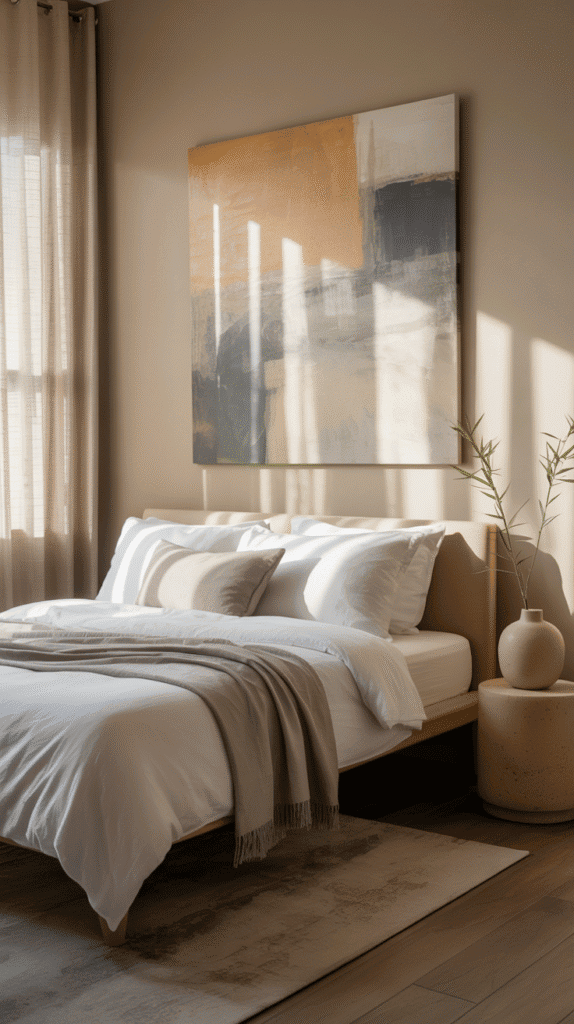
Walls looking a little bare? Good. Japandi doesn’t believe in cluttering up every inch of vertical space. But that doesn’t mean you can’t add intentional wall art that brings meaning and peace to your space.
The key here is restraint. Choose one or two large pieces instead of a gallery wall. Think oversized abstract prints, Japanese brushwork, a simple landscape, or even a framed quote in kanji (as long as you double-check the translation—no one wants to accidentally hang “soy sauce” over their bed).
Stick to monochrome or neutral color schemes to keep the calm going. Avoid anything that feels busy, chaotic, or overly trendy.
Can’t find art you love? Try your hand at DIY. A minimal ink drawing on handmade paper or a set of three natural-toned geometric prints can make a big impact without overwhelming the space.
Bottom line: every piece of art should feel like it belongs. Let your walls breathe, and let your mind relax.
9. Indoor Plants for Breathable Calm

You didn’t think we’d forget the plants, did you? A Japandi bedroom needs greenery. It’s like a breath of fresh air—literally and visually.
Plants bring softness, color, and life into an otherwise minimal space. But don’t overdo it. The goal is intentional greenery, not jungle vibes.
Some Japandi-friendly options:
- Snake plants: Hardy and architectural
- Olive trees: Elegant and muted
- Monstera: One statement plant is plenty
- Bonsai: Tiny but mighty zen
- ZZ plant: Low maintenance, high style
Place your plants in pots made from natural materials like clay, ceramic, or cement. No plastic, please. Bonus points if the pot itself looks handmade.
Keep them in corners, by the window, or even on your nightstand for a touch of organic calm. And if you don’t exactly have a green thumb? Faux plants are totally acceptable—just make sure they look real enough to fool your most plant-savvy friend.
10. A Bench at the Foot of the Bed
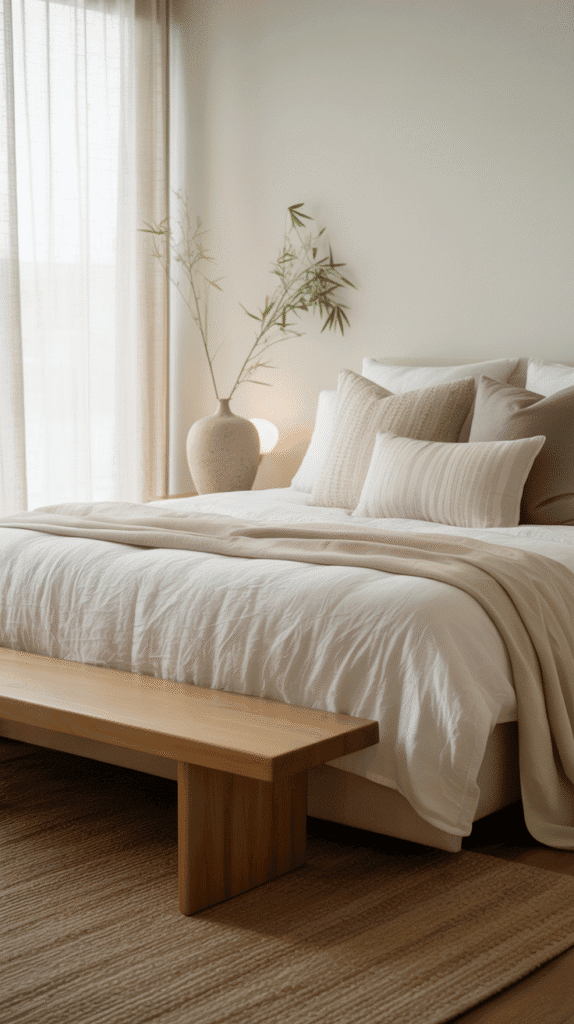
Adding a bench to the end of your bed might sound like a luxury, but it’s surprisingly practical. Plus, it’s the kind of touch that makes your room look instantly more pulled together.
It’s the perfect spot to:
- Lay out your outfit for the next day (adulting win)
- Stack a folded throw or extra pillow
- Sit while putting on socks or shoes
- Toss your bag or sweater when you’re too tired to hang it properly
For Japandi vibes, go for a wooden bench with clean lines or one upholstered in neutral fabric. Avoid anything bulky or overly decorative. We’re not trying to bring Versailles into your bedroom.
If space is tight, consider a low-profile stool or even a woven ottoman. Function meets minimalism? Yes, please.
11. Soft, Layered Window Treatments
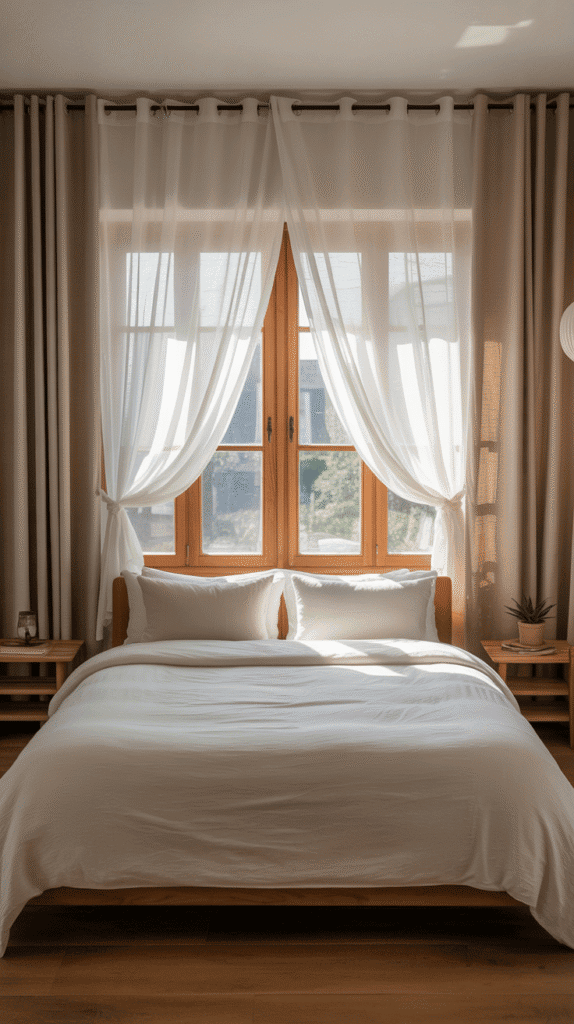
Lighting makes or breaks a room, and how you frame your windows is a huge part of that. In Japandi bedrooms, window treatments aren’t just for privacy—they soften the space and help control mood and light.
Start with sheer white or off-white curtains. They let natural light filter in beautifully during the day, which is key for that serene, airy feel. Then, layer on heavier linen drapes in a neutral tone for nighttime coziness and extra insulation.
Some style tips:
- Go floor-to-ceiling to elongate the room
- Keep rods simple (matte black or brushed brass works great)
- Stick to neutral, earthy hues like oatmeal, stone, or flax
Avoid anything fussy like tassels, loud patterns, or shiny fabrics. This is Japandi, not a Victorian parlor.
When done right, layered curtains make your bedroom feel finished, not overdone. And trust me, waking up to sunlight gently filtering through sheer panels? Instant good mood.
12. Organic-Inspired Decor Accents
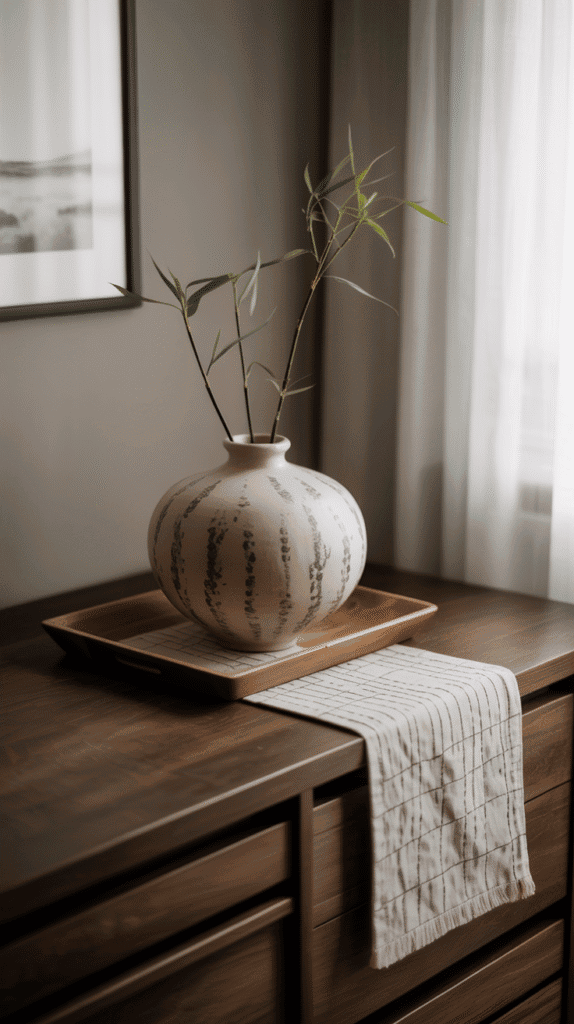
You’ve got the furniture, the bedding, the lighting—but what about the little touches? Japandi loves decor accents that feel handcrafted and one-of-a-kind.
A few go-to ideas:
- A ceramic bowl for your jewelry
- A small tray made of reclaimed wood
- A single sculptural vase with dried pampas or eucalyptus
- An asymmetrical lamp that adds quiet drama
Stick to natural materials: stone, clay, linen, rattan, or glass. These textures add interest without noise. And please, avoid cluttering every surface. One meaningful piece per area is enough.
These little details add warmth and humanity to a minimalist room. They make it feel lived in—not like a showroom. It’s all about choosing items that speak to you, even if they’re slightly imperfect. In fact, that’s kind of the point.
13. Cozy Floor Cushions or Tatami Seating
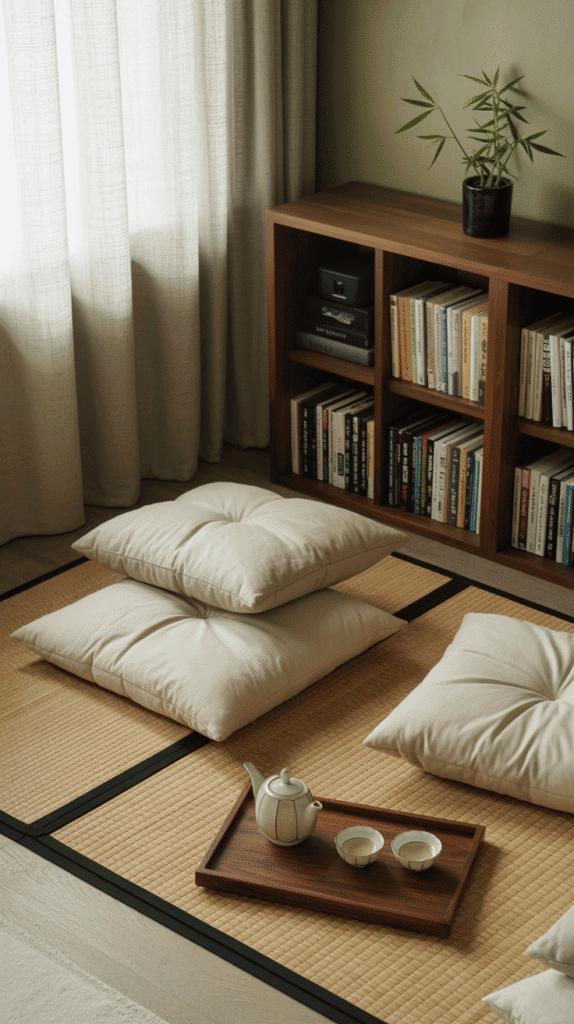
Let’s get comfy on the floor. Seriously. One of the most underrated elements in Japandi design is the use of floor seating or cushions. It’s relaxed, versatile, and totally zen.
Think about creating a corner with:
- A couple of floor cushions stacked neatly
- A soft tatami mat with a linen bolster
- A small side table for tea, books, or incense
This setup is ideal for morning meditation, reading, journaling, or just grounding yourself after a long day. Plus, it feels cozy and welcoming in a very unpretentious way.
Keep your cushions in earthy colors and natural fabrics like cotton, hemp, or linen. And make sure everything is soft but still structured. You don’t want to sink into a beanbag. Just… no.
Even if you don’t use this spot every day, having a floor nook tells your brain: “Slow down. Be present.” And we could all use more of that.
Bringing It All Home—Literally
So there you have it—13 Japandi bedroom interior design ideas that blend beauty, warmth, and peace in the most satisfying way. This isn’t about creating a magazine-perfect room. It’s about designing a space that calms your mind and feeds your soul.
Whether you start with a soft linen duvet or bring in a calming olive tree, remember: less stuff, more soul. Choose quality over quantity. Let things breathe. And most importantly, design your space around how you want to feel.
Now, tell me—are you already rearranging your room in your head? Because same. 🙂

This post shows 13 Minimalist Ideas Japandi Bedroom Interior Design!


